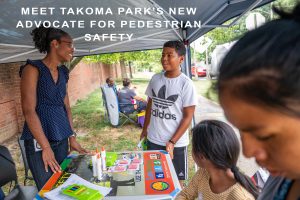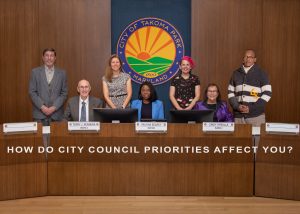by Gayle Stewart
Takoma Park Police Department Chaplain
Over the summer, several police departments around the country were in searches for police chiefs in addition to being in competition for police officers. Chuck Wexler, the executive director for the Police Executive Research Forum, a police think tank, commented on the police chief searches and said, “It’s a real challenge to find someone who meets the goal of dealing with crime while also reforming a police department.”
When I saw those words, I thought, We are fortunate, as I sat across from Chief Antonio DeVaul in his office—his arm was just out of the sling, having undergone shoulder surgery. We are fortunate in that we have a chief who understands the needs of this community and how to lead a police department. His office shows his love of policing. It is full of memorabilia, challenge coins, miniature police cars, awards, and certificates detailing his life in policing.
I’ve watched this department ever since I moved here in 1984 when my colleague Tony Fisher was chief. I have watched as officers were hired, advanced through the ranks, and then retired and went to other police departments. In the 1990s, I worked closely with the department in the implementation of community policing.
We’ve had a pretty good police department over those years, but with Chief DeVaul, we have an excellent police department, and he’s been able to do what Chuck Wexler believes is missing in policing: deal with crime and reform the department. During his five years as chief, he’s overseen a turnover of 70% of both sworn and civilian personnel. We have a brand-new police department that is aligned with and responsive to the needs of this community.
Tony Fisher, our first African American police chief, had an impact on 15-year-old Tony DeVaul, whose family moved to Takoma Park when he was 3 years old—such that when DeVaul joined policing, he wanted to emulate Fisher. Like many African American youth, DeVaul had not always had a good relationship with the City’s police, but he admired Chief Fisher and community sports leaders like Lee Jordan.
Tony DeVaul knew he wanted to make a difference when he joined policing, pursuing his career with Maryland-National Capital Park Police, before coming back to Takoma Park as the police chief.
Chief DeVaul says that preventing crime means looking at the root causes of crime and disorder and putting programs in place that address those issues. The chief is a proponent of recreational programs like those he participated in. He wants to help make sure that people have housing, jobs that pay a decent wage, and an education that points to a future. He wants young people to have the upbringing and opportunities he had because he knows that people—particularly young people—who have opportunities, who know they are valued don’t commit crime. He’s excited about the City’s mental health pilot program, through which two mental health counselors are embedded with police officers. Calls can be diverted from the police to those counselors, who are trained to handle people who are experiencing mental health crises. This frees up police officers for other calls that require their services.
Chief DeVaul encourages a guardian mentality rather than a warrior mentality. All of this is a culture change for the police and for the community. It takes a strong constitution to advocate for and make these changes—because there will be complaints, there will be pushback from those who want the police to just lock up people and from those who just don’t understand.
He has worked to raise morale among all department employees. Since Tony DeVaul became chief, the starting salary has been increased, and there are other incentives for officers to transfer from other departments. The reward and promotional systems have been changed so fairness is the underlying component. Transparency is also key when it comes to sharing crime data throughout the community. The department is fully staffed, something most departments around the country cannot say.
Diversity is key in the department that serves a diverse community. Across the department, officers speak seven languages. Residents can see themselves reflected in the backgrounds of the police officers, in the racial, gender, and sexual orientation of department members.
Is there still crime? Of course, there is. The only way to eliminate crime is to have a police state—and even then there will be crime. But, here, data are used to deploy officers and to determine how crime is managed. The focus is on serious crime, and officers are assigned to areas where they will have the most impact. Again, the focus is on prevention, with arrests as necessary. There are no arrest quotas in this department. Good police work is rewarded and encouraged.
The Takoma Park Police Department culture gives officers the latitude to make decisions in the best interests of the residents. That is innovative. And it is also difficult in a national climate in which every action of police officers is scrutinized and videotaped.
Chief DeVaul is both thankful for and proud of the department’s personnel who never know what type of reception they will receive when responding to a call or answering the phone. But there are more compliments than complaints and the chief is quick to praise personnel formally and informally. Personnel have gone out of their way to assist people in need and that is because of the culture that values people regardless of their circumstances.
Police personnel work with the weight of the world on their shoulders and then go home to their own families—that is the goal, to go home to their families. These officers have experienced horrific incidents, and still they keep plugging on.
Under Chief DeVaul’s leadership, the department was among the first police departments in the state to sign the 30/30 pledge which commits the department to having 30 percent of sworn personnel female by 2030. They have signed a pledge committed to transparency concerning body-worn camera footage. The department’s use-offorce policies are consistent with #8CantWait, which requires de-escalation before using deadly force. All operational procedures have been evaluated to ensure that they align with best practices and that they were consistent with the department’s changed philosophy to truly serve and protect.
Personnel have undergone Active Bystandership Law Enforcement (ABLE) training offered by Georgetown University that trains officers to “successfully intervene to prevent harm and to create a law enforcement culture that supports peer intervention” when they observe bad behavior on the part of other officers. His job, according to the chief, is to maintain a culture that encourages personnel to remain.
We have a police department that can serve as an example to others around the country. To be the chief of police is to be the hinge point between the department, the community, and government leaders. It is to be our contact for policing at the country, state, and federal levels.
To be chief is to put a human face on a system that resists reform and is derided by many—sometimes with good cause. And at the end of the day, to be chief is to be that 15-year-old teen who saw something in another chief and ended up leading that very same department.






